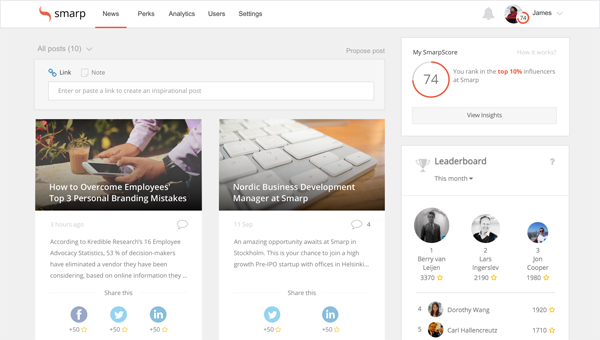Collaborative & Curated Social Media

The everyday conceptualizing, creating and circulating of content for social media can become monotonous for marketers responsible for this critical marketing channel. Should progress slow and performance falter, however, it will force brands to ask the question: Is it time to give up on social? In some ways, the answer is yes, but only in favor of a more collaborative and curated approach.
While it may seem harmless for a social media manager to be on auto pilot in respect to what he or she shares - content type, format and scheduling of posts, videos and promotions - the opposite is true.
There are a number of problems marketers face when trying to acquire and retain an audience of customers, users and followers on social media today and brands that choose to stick with the same strategies will have a more difficult time improving organic reach, taking on ad blockers (see sidebar), increasing engagement and, finally, showing real returns from the channel.
Even though many of the efforts made by today's social media managers appear weak at best, it's not time to give up on social media but rather relinquish sole control of the channel. With a more collaborative and curated management style, advocates and influencers can provide fresher ideas, greater reach and better results.
PUNCHING THE SOCIAL CLOCK
The way in which many organizations manage their social media stems from a near decade-old notion that social media is essentially a free marketing channel. As such, people volunteered or were "volun-told" to manage a company's social efforts (typically Facebook, Twitter and LinkedIn). These arrangements remain in effect across many businesses (the alternative being hiring an agency or dedicated social media manager), which explains the few hours a week that companies are allocating to social.
The most recent industry snapshot from Social Media Examiner indicates 34 percent of organizations (large and small) are still spending only 1-5 hours a week on social media management - meaning they have carved out time from their primary roles to manage the same top networks, using the same-old strategies - neither of which bodes well for capitalizing on this channel. There is little room for growth in this approach; little time to adjust strategies or explore emerging networks; little time to create new campaigns; and little time to make better decisions, which can often lead to no decision.
What is required in this new era of social media - where paying to play is becoming increasingly common - is a more collaborative and curated style and approach. Luckily, there are many software solutions allowing brands to give up social in favor of a more measurable and effective practice.
REACHING AN AUDIENCE
Organic reach is crippling under the weight of algorithm updates designed to limit brand exposure (developed in the name of user experience, of course) and help networks sell more ads. There will soon be nothing left for brands relying on organic posts to reach audiences within Facebook, Instagram and Twitter - all of which now have highly refined "quality" filters. A creative approach is required, yet marketers are already under time constraints balancing their many existing responsibilities. Enter: influencers.
Popular Pays
The chances are slim of opening up Instagram (and increasingly Snapchat) and not seeing a celebrity (or pseudo-celebrity), athlete or blogger promoting weight loss programs, drinks, apparel, subscription boxes or other merchandise. Bringing on influencers to share a company's message is smart in many ways - and not just for those in B2C markets. For one, Instagram's algorithm (in both its feed and stories) filters what users see - relying on engagement signals to prioritize posts. Companies with low engagement prior to the algorithm release likely have even lower engagement after it (wsm.co/postalgo), yet many influencers still enjoy the reach that networks once provided the rest of us since they're actively sought after by each network's users and often yield far higher reach than a brand could achieve alone. What's more, Forrester reports that consumers engage with 11.4 pieces of content prior to a purchase, which means influencers can be used to complement a brand's messages rather than control it - a collaborative approach.
Popular Pays is a marketplace for finding these types of influencers. The platform "connects brands with stories to tell and the content creators who'll help them tell it." In exchange for posting about brands on Instagram, "creators" get free products or cash. Popcorn brand Skinny Pop, for instance, selected creators for a campaign that showed off #SkinnyPopLove to followers: "how, when and why" they love SkinnyPop Popcorn, shared in their own unique style. When the campaign ended, there were 30 total participants who created 90 pieces of content (see image).

The posts reach 2,918,936 people for 698 comments and 38,810 likes - as the result of a collaborative and curated social experience. These campaign types work because they fit the channel they are on (also known as native advertising).
Even great content will not resonate with an audience if it's seen as out of place by a social network's users according to Popular Pays CEO Corbett Drummey. He believes the biggest benefit to influencer marketing is handing the brand story over to someone else to tell (also a perk for time-strapped marketers).
"People believe it more since it's authentic, and we've seen that in the data everywhere from increased engagement, brand lift and conversion," said Drummey. "Brands are often pleasantly surprised when they see the ways that creators use their products in everyday life. It's refreshing to hear that side of the story."
These native ad formats, however, are catching the eye of the Federal Trade Commission (FTC), so companies have to be mindful of the approach and methods they adopt.
"We pay very close attention to the FTC," said Drummey. "It's important that we're informed on current regulations and communicate that to our community of creators and our brands. We have buy in from our community as they're just as concerned with transparency with their audiences as we are. The platform also has some checks in place to ensure compliance. Every creator's post and caption prior to posting is given a stamp of approval from the brand."
To remain compliant, businesses should require transparency like using the #ad hashtag within influencers' posts while also keeping an eye on new capabilities within Instagram and its parent company Facebook, which leverage influencer marketing's popularity and effectiveness.
Direct Selling
Instagram currently does not offer a native way to shop directly within the app. If a person is interested in a product or service promoted by an influencer, they can typically tap on the image to see which brands are tagged, go to their profile and then visit the link in their bio. It's a workaround that needs improvement.
Instagram has made upgrades in this regard but within paid media where calls-to-action (CTAs) like "shop now" or "download now" are more prominent in the news feed ads and also carry over when a person goes to a company's profile. Startups also exist that curate and provide links within popular Instagrammers' posts, but in a way, says Bigcommerce Group Product Manager Nate Stewart, Facebook and Instagram are unseating these startups by doing it themselves.
Product tags, for instance, are currently being tested by Facebook. For the unfamiliar, they offer the ability to tag an image with the product and make it purchasable. While still in its infancy, Stewart expects this feature to play a big role in social commerce particularly when it comes to content curation.
If an influencer is wearing items, eating food or visiting a location that a person is interested in, very soon that user will be able to buy or book the product directly within the app. Currently, however, select brands (Pages with a shop section, which is still a feature being tested) will have to share an Instagram post on Facebook in order to tag the products.
Two significant advancements by Facebook and partners (like Bigcommerce) are in how they process and support the actual completion of social orders internally or externally. Bigcommerce merchants, for instance, can either direct checkouts to their e-commerce site from their Facebook Shop or, and this is new, use Facebook Checkout to allow shoppers to complete their orders natively within Facebook (via PayPal and powered by the Braintree gateway).
The ability for retailers to tag products in influencers' photos and have shoppers complete the checkout directly within Facebook (and seemingly Instagram in the future) is significant when we know just how well influencer marketing works.
Bigcommerce brings value to retailers interested in social commerce by simplifying selling across a number of different channels (syncing product catalogs) like Facebook and Pinterest (and even Amazon) while managing inventory and order processing through a single interface - the Bigcommerce dashboard. With that, merchants can convert more sales without requiring any additional work on the back-end.
The increasing popularity of automatic product feeds, native checkout capabilities, influencer marketing and content curation make a strong case for where the industry is heading - minimizing the intervention needed by brands to manage social media.
Activating Advocates
Social media managers have their pick of tools to identify their most engaged customers (e.g., SocialRank) and locate industry influencers (e.g., Popular Pays, BuzzSumo, Followerwonk), but the best advocates may be who they speak to every day or casually pass by in the hall - their coworkers.
Dedicated employees are often the people who most staunchly contribute to, defend, and eagerly promote a company's products or services. Enter: employee advocacy.
There are many benefits to employee advocacy programs: (1) they likely won't fall under FTC jurisdiction; (2) they are suitable for all industries (particularly as many offerings, like those mentioned above, cater to retailers); (3) they can increase the organic reach and engagement marketers so desperately covet; (4) they may appear more authentic than the previously mentioned native advertising types; and (5) they will help managers beat the social fatigue and lackluster decision-making that goes along with everyday management of this channel.
Since there is very little chance that a company's employees are not already actively engaged on social media throughout their workday (Bambu by Sprout Social indicates 7 in 10 people check social networks while at work), brands should harness the advocacy power that this user group can offer.
Despite so many benefits, employee advocacy programs have been slow to take off, and marketers are partly to blame - isolating their social media efforts to retain control in the name of consistent brand messaging. This attitude has resulted in nearly 60 percent of people saying they aren't given ample guidance from their marketing department on how and when to advocate for their brand (Bambu, 2016).
The status quo of employee advocacy has to change as people are 16 times more likely to read a post from a friend than from a brand themselves (Bambu, 2016). Employee advocacy programs can also provide on-brand collaborative environments that are mutually beneficial to the employee and employer relationship.
Enterprises like Deloitte and Nissan have found the solution for mobilizing their staff within SMARP, a Web and mobile app. With SMARP, admins include the content they want employees to post. Staff members then go to the dashboard, find something they want to share and click (suggested copy and hashtags are included but can be edited).

Using the pulls of gamification, employees accrue points for each share, which are tallied in a company-wide leaderboard and can be redeemed for swag or other rewards.
Social media managers are drawn to offerings like SMARP because they aren't giving away the house - letting employees post whatever they want on their behalf. Rather, they select content for employees to circulate within their networks (particularly important for regulated industries) while still giving staff members some control by letting them select which content and adjusting the copy of their posts/tweets to their role and style.
To increase participation, the content that is fed into the SMARP dashboard should be valuable for the individual, their network and the company. SMARP Co-founder and COO Mikael Lauharanta says providing value to all three is key.
SMARP pulls together all the fundamentals of social media today: providing engaging content (often curated), allowing influencers to share it to increase reach and calculating the return on those efforts. It's community driven, it's curated and it's proven to work.
Admin users can access the company's analytics, which shows a breakdown of clicks and calculated earned media value (how much money the brand would have spent if it promoted posts instead, used LinkedIn advertising, etc.). Companies know how much they pay for SMARP and can see how much they would have paid to get the same reach.
This is where many marketers today, however, typically end their social calculations. SMARP helps them go a step further (like everyone should) and feeds the data into the company's website analytics provider of choice and by using UTM tags allows brands to see how long visitors spent on the site, which pages they visited, and if they completed any goals or conversions like applied for a position or bought something (learn more at 5 Tips To Prove Social's ROI).
Employee advocacy programs help employees boost individual goals: sales can make more sales, HR can make more hires and content creators can get more page views. Calculating return, increasing reach and better automating social media tasks - the trifecta of social media today.
HANDS-OFF? NOT ENTIRELY.
Companies have stories to tell and products to sell, so they want current/potential customers to listen now and in the future. Social media presents the near-perfect opportunity to exchange those messages and build brand loyalty, but increasingly companies are required to pay for placement and battle their own (as well as their users') heightened fatigue of the channel. By leveraging influencers, getting more user-generated content, and keeping shoppers/buyers/users on the platform of their choice, brands will position themselves for success.
This type of collaborative approach to social media isn't entirely hands-off, however, as this strategy requires that brands keep an ear to the digital ground to monitor mentions and adjust their approach accordingly.

Subscribe to Our Newsletter!
Latest in Social Media










